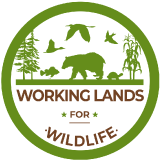-
 The Effects of Livestock Grazing on the Bog Turtle
The Effects of Livestock Grazing on the Bog Turtle
-
by
Rhishja Cota
—
published
Nov 08, 2022
—
last modified
Jul 24, 2023 11:27 AM
—
filed under:
Reptile,
Additional Resources,
Livestock,
Habitat loss,
Bog Turtle,
Product,
Research,
Peer-reviewed Science,
Aquatics,
Bog Turtle Additional Resources,
Grazing,
Resources
The demise of small-scale dairy farming over the past three decades has led to the pastoral abandonment of the majority of bog turtle habitats in the Northeast. As a consequence, habitats are being degraded by the growth of invasive flora, changes in hydrology, and the loss of turtle microhabitats created by livestock.
Located in
Information Materials
/
Research
/
Peer-reviewed Science
-
 Virtual tour: Native Warm Season Grass Grazing
Virtual tour: Native Warm Season Grass Grazing
-
by
Admin
—
published
Dec 30, 2020
—
last modified
Mar 04, 2022 04:54 PM
—
filed under:
Working Lands,
Northern Bobwhite Quail,
Instructional Video,
Conservation,
Video,
Working Lands for Wildlife,
Landowner Information,
Grazing
Join a tour of pasture lands that use native warm season grasses to provide good grazing for livestock and invaluable habitat, food, and shelter for native wildlife. The video highlights the benefits of different native grasses and how quickly these grasses can benefit working lands.
Developed and provided by Ohio NRCS, Ohio State University Extension, the Madison Soil and Water Conservation District, and Quail/Pheasants Forever. Released September 2020.
Located in
Training
/
Videos and Webinars
-
 Winter Grazing - a Better Way to Feed
Winter Grazing - a Better Way to Feed
-
by
Admin
—
published
Jun 17, 2021
—
filed under:
Winter Grazing,
USDA,
Grasses,
Webinar,
North Carolina,
Video,
NRCS,
Cattle,
Native Grasslands,
Grazing,
Livestock
In this video, three livestock producers describe how extending the grazing season with winter grasses has saved them time and money, while also improving the environment; and they demonstrate the methods they used to achieve these savings. Sponsored by the NRCS - East National Technology Support Center.
Located in
Training
/
Videos and Webinars


